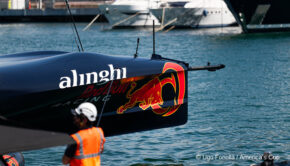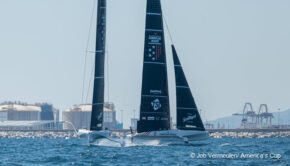America’s Cup: Update from Auckland
Published on November 21st, 2020
North Sails has a long history with the America’s Cup, supplying every America’s Cup Defender and Challenger since 1988. With all four contending teams for the 36th America’s Cup now training on their AC75 race boat, North Sails provides an update from the action:
North Sails and defender Emirates Team New Zealand (ETNZ) recently hosted an evening of discussions at the ETNZ base, kicked off by an exclusive virtual video from North Sails President, Ken Read in Newport, Rhode Island, announcing his plans to come to New Zealand to commentate for the duration of the America’s Cup.
North Sails Auckland General Manager, Richard Bicknell, introduced North Sails designer and speaker for the evening, Burns Fallow. As one of the most sought-after sail designers in the world and a colleague of Bicknell’s for 20 years, Fallow started working for North Sails in 1988 and has since been heavily involved in the Whitbread, Volvo Ocean Race, and the America’s Cup, with this cycle marking his sixth Cup; a special milestone to reach.
From Grand Prix to Superyacht sails, Fallow holds an international presence in sailmaking and takes great pride in designing sails for more local boats as well. He also spent time mentoring younger designers across the globe, namely Gautier Sergent in 1999 who is now the chief sail designer for INEOS TEAM UK.
We have compiled our key takeaways from the in-depth discussions had by Burns Fallow and teammate Rob Salthouse:
1. The AC75s are the fastest monohulls ever to sail upwind:
Reaching speeds of 20 knots velocity made good (VMG) upwind, the AC75 marks the evolution of sailing over the last 20 years. No other sport in the world has seen improvement like this over such a short time. “The AC75 Class Rule is the bible that we have to abide by in terms of specifications of the yacht,’’ Fallow explains. “The rules can sometimes get in the way of great ideas, but in this class, unlike the last couple of Cup cycles, it has been left reasonably ‘open-ended’ to let different teams express themselves from a design point of view.’’
2. Why do we want boats to fly?
It is a reduction of drag. Carrying a hull through the water when sailing upwind or downwind, the boat is going to travel slower than if you can just rely on the foils to balance all of the aero-forces.
3. Key Design Areas:
Hull: With an overall length of 75-feet (including bowsprit), the four teams weigh within 1 kg of each other. The foils and cant-axis are fixed, and so is the displacement. All of these factors are tightly policed.
Foil Wings: Sitting at the bottom of the foil, the wings are an active area of development and a highly critical part of the design process. The tab on the back of the foils is controlled manually to make the boat fly high or low.
Rudder: The AC75’s have a single rudder on the centerline with a horizontal wing (elevator) at the back. The elevator is an actively controlled surface and thus has limits in width, height, and length to help maintain flight.
Rigs: The rigs are only just longer than the boat at 26.5m compared with the AC72 (from 2013), which had a 40m mast length. The AC72 and AC75 weigh about the same with a similar righting moment, but in place of a keel, the AC75 has two foil arms, so a taller mast would affect the stability of the boat when off the foil. This can make the transition period tricky when trying to get the boat to take off, so requires a lot of management.
Double-skin Mainsail: Large D-Section spar with a pair of mainsails hoisted together to retain traditional concepts of sail design. The double-skin reduces drag by stopping the sails flapping through the tacks and is also very stable through maneuvers.
4. Racecourse:
Races will start later in the day (~16:00 NZDT) to increase the chances of a good sea breeze developing and also working better for coverage around the world. The pre-start will be between 2.5-3 minutes, starting upwind with a windward leg followed by two or three laps to the finish. The typical race length is expected to be approximately 25 mins.
5. All North Sails teams are using full 3Di inventories:
Fallow comments, “It gives me a huge amount of flexibility as to where I want to put tapes. If I’ve got a problem area in a sail which I spot in the simulations, I can put some tape there. The makeup of the fabric is the same as what we might use for any boats with 3Di sails. The primary difference is the percentage of carbon we might put in relation to the Dyneema from a longevity/toughness point of view. But our sails are built on the same machines, same molds, same design software.’’
6. All the operations and functions of the foils are manual:
There is no ‘follow-the-dot’ (as used by the Kiwi team in 2017). Controlling the foils lies all in the hands of the guys onboard who are doing other jobs as well. They’ve got a lot on!
Details: www.americascup.com
36th America’s Cup
In addition to Challenges from Italy, USA, and Great Britain that were accepted during the initial entry period (January 1 to June 30, 2018), eight additional Notices of Challenge were received by the late entry deadline on November 30, 2018. Of those eight submittals, entries from Malta, USA, and the Netherlands were also accepted. Here’s the list:
Defender:
• Emirates Team New Zealand (NZL)
Challengers:
• Luna Rossa (ITA) – Challenger of Record
• American Magic (USA)
• INEOS Team UK (GBR)
• Malta Altus Challenge (MLT) – WITHDRAWN
• Stars + Stripes Team USA (USA) – STATUS UNCONFIRMED
• DutchSail (NED) – WITHDRAWN
Of the three late entries, only Stars+Stripes USA remains committed, however, it is unclear what entry payments have been made, nor is there knowledge of a boat being actively built or sailing team assembled.
Key America’s Cup dates:
✔ September 28, 2017: 36th America’s Cup Protocol released
✔ November 30, 2017: AC75 Class concepts released to key stakeholders
✔ January 1, 2018: Entries for Challengers open
✔ March 31, 2018: AC75 Class Rule published
✔ June 30, 2018: Entries for Challengers close
✔ August 31, 2018: Location of the America’s Cup Match and The PRADA Cup confirmed
✔ August 31, 2018: Specific race course area confirmed
✔ November 30, 2018: Late entries deadline
✔ March 31, 2019: Boat 1 can be launched (DELAYED)
✔ 2nd half of 2019: 2 x America’s Cup World Series events (CANCELLED)
✔ October 1, 2019: US$1million late entry fee deadline (NOT KNOWN)
✔ February 1, 2020: Boat 2 can be launched (DELAYED)
✔ April 23-26, 2020: First (1/3) America’s Cup World Series event in Cagliari, Sardinia (CANCELLED)
✔ June 4-7, 2020: Second (2/3) America’s Cup World Series event in Portsmouth, England (CANCELLED)
• December 17-20, 2020: Third (3/3) America’s Cup World Series event in Auckland, New Zealand
• January 15-February 22, 2021: The PRADA Cup Challenger Selection Series
• March 6-15, 2021: The America’s Cup Match
Youth America’s Cup Competition (CANCELLED)
• February 18-23, 2021
• March 1-5, 2021
• March 8-12, 2021
AC75 launch dates:
September 6, 2019 – Emirates Team New Zealand (NZL), Boat 1
September 10, 2019 – American Magic (USA), Boat 1; actual launch date earlier but not released
October 2, 2019 – Luna Rossa (ITA), Boat 1
October 4, 2019 – INEOS Team UK (GBR), Boat 1
October 16, 2020 – American Magic (USA), Boat 2
October 17, 2020 – INEOS Team UK (GBR), Boat 2
October 20, 2020 – Luna Rossa (ITA), Boat 2
November 19, 2020 – Emirates Team New Zealand (NZL), Boat 2
Details: www.americascup.com









 We’ll keep your information safe.
We’ll keep your information safe.